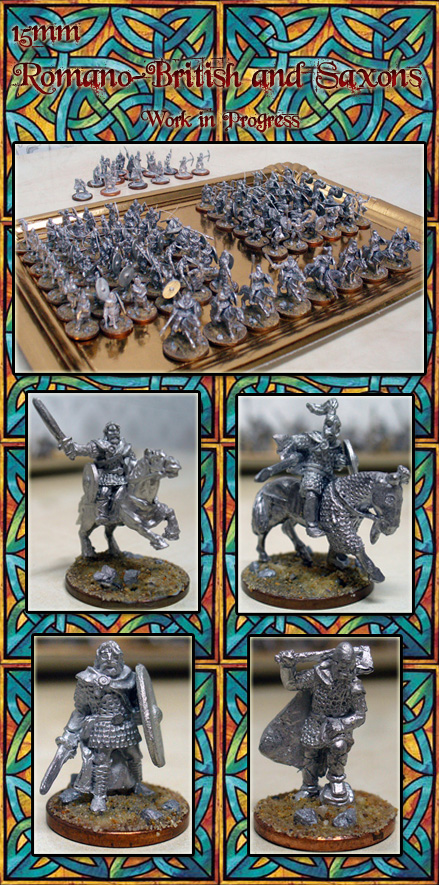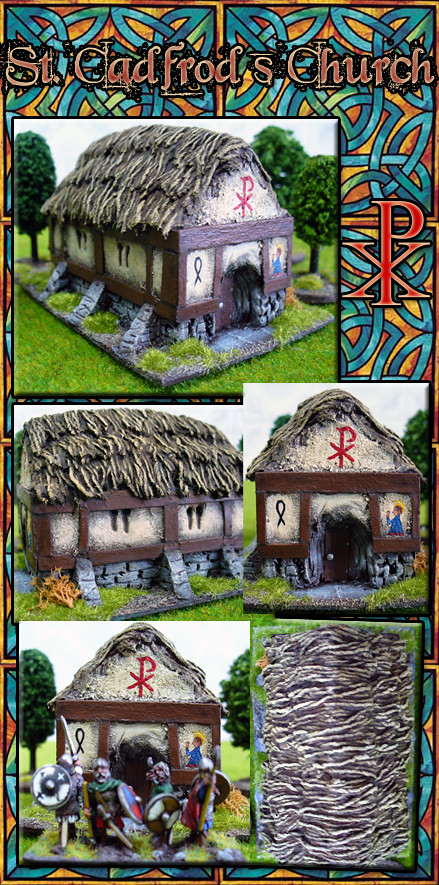
domingo, 29 de agosto de 2010
Thegn and Dryhten
The saxon leaders ready for battle. These are the boss, a Thegn, and his close henchman, a Drythen. Superb Splintered Light models.


jueves, 26 de agosto de 2010
Wulfbyrnan and Hraefnhelmas
A couple of dangerous guys, a Wulfbyrnan and a Hraefnhelmas. They are adpts of ancient warrior cults from their ancestral continental homeland. We could also simply call them berserkers.
The warrior with the spear is painted as a tribute to a well known movie from the eighties.

The warrior with the spear is painted as a tribute to a well known movie from the eighties.

lunes, 23 de agosto de 2010
Geoguth and Galdre
A couple of saxon characters. These are a Geoguth and a Galdre.
A Geoguth is a young warrior looking for a chance to test his courage. A Galdre is a saxon priest.

A Geoguth is a young warrior looking for a chance to test his courage. A Galdre is a saxon priest.

lunes, 16 de agosto de 2010
Gesiþas
The term Gesiþas comes from the Old Saxon gisīð, and this from the Old High German gisindo, meaning companion or comrade.
The Gesiþas are good armoured troops from the low nobility or great renown warriors choosen by a Thegn or a Dryhten.
They are an armoured version of th Geoguþe, carrying spears as well as hand weapons, such as swords or axes. They are protected by chainmails.
Freehand painted shields again.



The Gesiþas are good armoured troops from the low nobility or great renown warriors choosen by a Thegn or a Dryhten.
They are an armoured version of th Geoguþe, carrying spears as well as hand weapons, such as swords or axes. They are protected by chainmails.
Freehand painted shields again.



sábado, 14 de agosto de 2010
Langbogascéotendas & Geoguþe ready for action
The varnish isn't matt enough yet, but it would be in a few days.
All of them are washed in Rembrandt's Vandyke Brown.



All of them are washed in Rembrandt's Vandyke Brown.



martes, 10 de agosto de 2010
Saxon light spearmen WIP
The Geoguþe are ready to be washed and have their bases done. Finally I've choice to paint their shields using freehand instead of transfers; it's a quite hard job, but I think they deserve it.
The Geoguþe are light spearmen, carrying a shield but unarmoured.


The Geoguþe are light spearmen, carrying a shield but unarmoured.


domingo, 8 de agosto de 2010
Saxon longbowmen WIP
I've started my saxon warband painting the Langbogascéotendas (longbowmen with shields at their backs). They'll be just six, so it would be fast to get them painted and I can also start practicing with the shields, although these are smaller than the spearmen ones.
This is how they look before washing, varnishing and working their bases.


This is how they look before washing, varnishing and working their bases.


viernes, 6 de agosto de 2010
Gathering the warbands
My warbands from Splintered Light Miniatures arrived a few days ago. Around a week since I ordered them; that is a really good service considering they came from Georgia (US) to northern Spain.
I really liked them when I first saw them in their webpage, specially those characters packs which are really useful for Brytenwalda. But, believe me, they look even better when you can see them on your hands. This also goes for the horses, which don't look that good when on their web, but they are great... even better than others 15mm manufacturers (around Essex horses standard in my opinion). The models are very good done, and it's hard to find a mould line.
I have take this pic in order to take a look on compatibility and so. It is a SL armoured saxon spearman surrounded by miniatures from some of my DBA armies. It fits quite good with all of them, but the Xyston hoplites look a little bit bigger (they are more 18mm than 15mm, to be honest). I've forgotten to put some Alain Touller models in the picture, but they fit great too.

And here is a WiP of my Brytenwalda warbands. You can see a british teulu, Arthur (on Essex horse), a teulu on foot and a saxon thegn on the solo pics.
The infantry miniatures are based on 1 cent euro coin and cavalry goes on 5 cent euro coins. They are a perfect size for them and add a good weight at the base.

I really liked them when I first saw them in their webpage, specially those characters packs which are really useful for Brytenwalda. But, believe me, they look even better when you can see them on your hands. This also goes for the horses, which don't look that good when on their web, but they are great... even better than others 15mm manufacturers (around Essex horses standard in my opinion). The models are very good done, and it's hard to find a mould line.
I have take this pic in order to take a look on compatibility and so. It is a SL armoured saxon spearman surrounded by miniatures from some of my DBA armies. It fits quite good with all of them, but the Xyston hoplites look a little bit bigger (they are more 18mm than 15mm, to be honest). I've forgotten to put some Alain Touller models in the picture, but they fit great too.

And here is a WiP of my Brytenwalda warbands. You can see a british teulu, Arthur (on Essex horse), a teulu on foot and a saxon thegn on the solo pics.
The infantry miniatures are based on 1 cent euro coin and cavalry goes on 5 cent euro coins. They are a perfect size for them and add a good weight at the base.

miércoles, 4 de agosto de 2010
Kingdom of Gwent: 520 AD
The whole Dark Ages romano-british town is finished. It's made of foam, string and cadboard.
Being in 15mm it was quite easy and fast to built up.
These buildings represent a town close to Colonia Nervia Glevensium (Gloucester), in the area which was the eastern frontier of the kingdom of Gwent during the VI century. Close to Lloegyr, a very dangerous place... and a good area to play saxon raids in Brytenwalda!
The buildings are simple houses with straw roofs where one or more families used to live in. This is the same basic structre that we can see today on the popular english and irish cottages.The materials are quite more exquisites than those that we could find deep into Cambria during that age, like the comunal timber houses of Brycheiniog and Morgannwg. You can see even an old tiled roof building maybe made by the romans more than a century ago. The smaller buildings were used to keep food; think on the local harvest or smocked meat and fish.

Being in 15mm it was quite easy and fast to built up.
These buildings represent a town close to Colonia Nervia Glevensium (Gloucester), in the area which was the eastern frontier of the kingdom of Gwent during the VI century. Close to Lloegyr, a very dangerous place... and a good area to play saxon raids in Brytenwalda!
The buildings are simple houses with straw roofs where one or more families used to live in. This is the same basic structre that we can see today on the popular english and irish cottages.The materials are quite more exquisites than those that we could find deep into Cambria during that age, like the comunal timber houses of Brycheiniog and Morgannwg. You can see even an old tiled roof building maybe made by the romans more than a century ago. The smaller buildings were used to keep food; think on the local harvest or smocked meat and fish.

martes, 3 de agosto de 2010
Saint Cradfrod's church
This is the first scenery model for Brytenwalda I've finished. It's the first building for the project of a Dark Ages village in 15mm.
The structure is made of foam and the straw roof is made of string.
Saint Cadfrod was bishop of Caerleon (close to Newport, in South Wales) between the IV and V centuries.

The structure is made of foam and the straw roof is made of string.
Saint Cadfrod was bishop of Caerleon (close to Newport, in South Wales) between the IV and V centuries.

Suscribirse a:
Entradas (Atom)
